13 Product Feedback Form Templates and Examples

By Dayana Mayfield
Last updated on Thu Jun 23 2022
Without a steady stream of feedback, you'll be in the dark about what customers really have to say about your products.
Product feedback forms are a little bit different from customer research surveys because they are generally always available online, as opposed to being sent out occasionally via email. Forms can include survey questions or contain just one blank field for open-ended feedback.
In this guide to product feedback forms, we share 7 templates and 6 examples.
Pros and cons of using a product feedback form
Feedback forms are a common way to collect feedback directly from customers so that you can reiterate on your product and make it better. Here are the pros and cons.
Pros
Feedback forms are generally great for these reasons:
Helps you build what customers want
Can offer open-ended feedback or targeted feedback based on the form fields
Ideas can be collected regularly
Cons
Feedback forms do have some negatives:
Usually not public (ideas disappear)
Not possible for customers to upvote each other's feedback
Not engaging or collaborative
In order to combat these downsides, you can use a website feedback tool. Look for something that offers an idea board and roadmap (can be public or private to signed-in users). Allow users to upvote and comment on each others' ideas to not only make it more collaborative but to also help you with feedback prioritization.
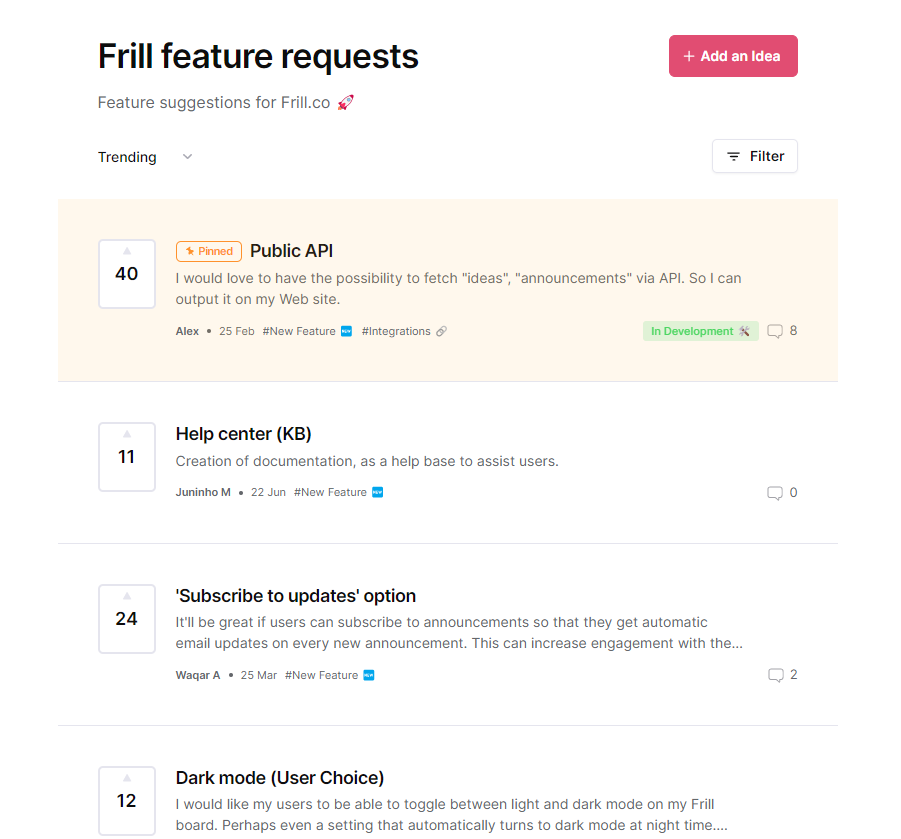
7 Product feedback form templates
Here are several different templates to help you determine what to put in your form. Depending on your goals, you can ask very specific questions, or leave things more open-ended. Be sure to have at least one open-ended form field to allow users to input any sort of idea or feedback.
1. Small business SaaS product feedback form template
Managing customer feedback as a SaaS company is essential. Unlike consumer products, you can't just liquidate your inventory if your product is a total flop. If SaaS companies don't build products that users truly want, they will suffer to reach or sustain profitability. In fact, a product that spreads like wildfire, either through built-in virality or word-of-mouth, is the best way to run a profitable SaaS. And to do that, you need a tool that customers love.
This feedback form template is designed for SaaS companies that target small business owners and solo firms.
Form template:
Why did you choose [product name]?
What were you using before you tried [product name]?
What tasks do you manage with [product name]?
How has [product name] impacted your business?
What features of [product name] are your favorite?
What features or improvements do you wish [product name] had?
Is there anything else you would like to tell us about [product name], your experience with us, or anything else?
2. Enterprise SaaS product feedback form template
Enteprise SaaS products are a bit different. They're intended for use by large enterprises, non-profits, or government organizations. As such, the questions that you ask in your product feedback form (about your non-profit marketing software, for example) should be different too.
Use this template when reaching out to enterprise users, and consider tweaking it for different user segments (especially decision-makers versus main users).
Form template:
How do you use [product name]?
How do others on your team use [product name]?
What are your favorite features of [product name]?
What features or improvements would you like to see?
How does [product name] impact your productivity?
Have you used other tools that are similar to [product name]? If so which ones?
What did you like better about those other tools?
What do you like better at [product name]?
Would you recommend [product name] to others? Why or why not?
3. Consumer app product feedback form template
When requesting feedback on an app for consumers, the questions you ask should be different than what you would ask for a B2B app. Depending on your monetization strategy, (free with ads or paid subscription), you can modify the questions that have to do with cost.
Form template:
Why did you sign up for [app name]?
Did you [app name] meet your initial expectations?
What are your favorite features of [app name]?
What would you like us to change or improve?
Is [app name] worth the cost?
What other similar apps have you tried?
Would you recommend [app name]? Why or why not?
4. Consumer product feedback form template
For a physical product like a toaster, hair dryer, t-shirt, ladder, or any other type of consumer product, use this feedback form template.
Form template:
What was your initial impression of [product name]?
How does [product name] compare to similar items you've purchased in the past?
How can we improve [product name]?
After purchase [product name], do you plan on buying from [brand name] again? Why or why not?
Do you have suggestions for additional products or accessories that you would like us to create?
Would you recommend [product name]? Why or why not?
5. Consumer course product feedback form template
Online courses have exploded in popularity and the market isn't slowing down anytime soon. From 2020 to 2026, elearning is predicted to grow 32.1%. If your product is a digital learning product like a course or ebook, use this template to gather input from your customers.
Form template:
Why did you decide to buy [course name]?
Did [course name] meet your initial expectations?
Was there anything not included in [course name] that you were hoping or expecting to see?
How has [course name] impacted your life?
If you could go back in time, would you still purchase [course name]?
How can we make [course name] better? Any feedback for the curriculum, community, or support?
6. Business course product feedback form template
Courses for business owners and professionals can be very profitable digital products. When working with B2B buyers, you should ask additional questions about the business impact and you might also want to understand how you can add additional courses and services to build out your value ladder.
Form template:
Why did you decide to buy [course name]?
Did [course name] meet your initial expectations?
Was there anything not included in [course name] that you were hoping or expecting to see?
How has [course name] impacted your business?
Are you able to put a number on that impact?
Would you recommend [course name] to other business owners?
How can we make [course name] better? Any feedback for the curriculum, community, or support?
After purchasing [course name], what else would you like [company name] to help you with? What do you wish we would offer next?
7. Professional services feedback form template
While services aren't products per se, there are now many companies in the services industry that have managed to productize their services. Picture a marketing agency with a simple monthly subscription for graphic design services, for example. Or a personal trainer who offers a set number of virtual 1:1 sessions a month.
If you offer productized services, then try this template for gathering customer feedback.
Form template:
What were you hoping to achieve by signing up for [service name]?
Are you satisfied with [service name]?
What could we do to make [service name] better?
What additional services do you want [company name] to offer? How important are those suggestions to you?
Have you ever tried one of [company name]'s competitors?
How does [company name] compare to our competitors? What do we do better? What do they do better?
Anything else you'd like to tell us about your overall experience with [service name]?
6 Product feedback form examples
For even more inspiration, we've found some great examples of product feedback forms out in the wild. These examples have been pulled from a variety of industries and can be easily adapted to match your business.
1. Frill's product feedback form and public idea board
In this example, the team at Frill uses our own customer feedback software in order to collect ideas from our users. They can submit an open-ended idea at any time on our idea board.

What's also great about this method is that Frill shows the roadmap with the submitted ideas, ideas under consideration, and the already shipped ideas (to show that customer feedback is being taken seriously.
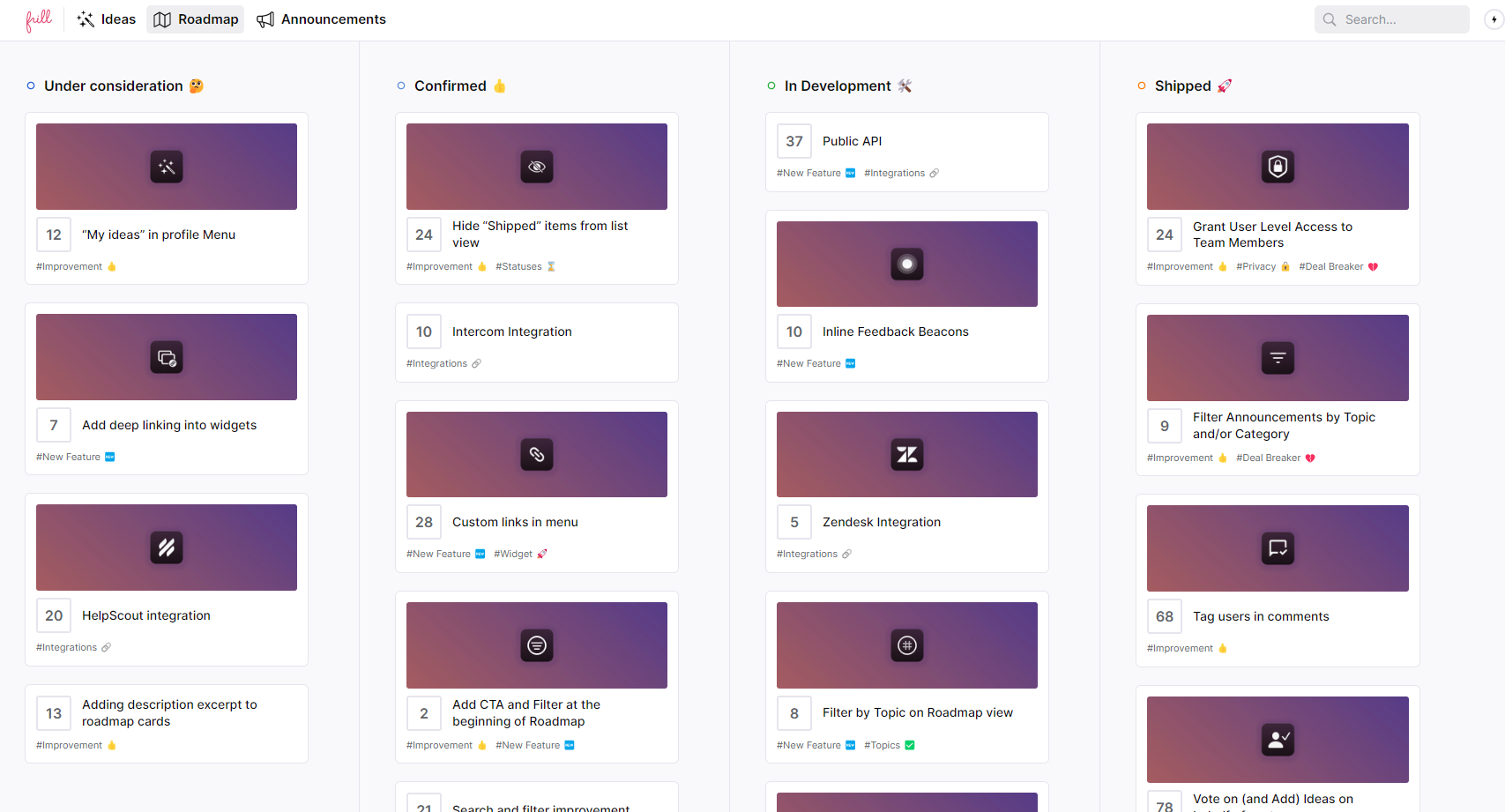
2. Asana's product usage and feedback request
Project management tool Asana recently sent out a survey requesting product feedback. But before getting to that part, they made sure to ask questions that would help the team better understand where the user is coming from.
They asked what device users typically use.

And they also asked what types of workflows the user relies on Asana for.

3. Madison Reed's NPS score and feedback form
At-home hair color brand Madison Reed uses the Net Promoter Score (NPS) system to find out how likely customers are to recommend the brand to their friends.

After the score is submitted, they then ask why the customer chose that score in order to discover more behind the reasoning. Within this form, they undoubtedly collect tons of product feedback, both positive and negative.
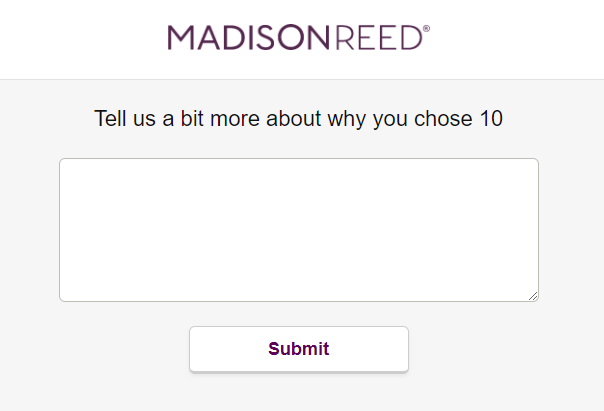
4. Curator.io's roadmap and feedback widget
Curator.io, a social media aggregator for adding social posts to your website, has embedded Frill's feedback widget in their web app product in order to collect feedback around the clock. They also show off their product roadmap so users can see what's on the way and upvote ideas from other users.
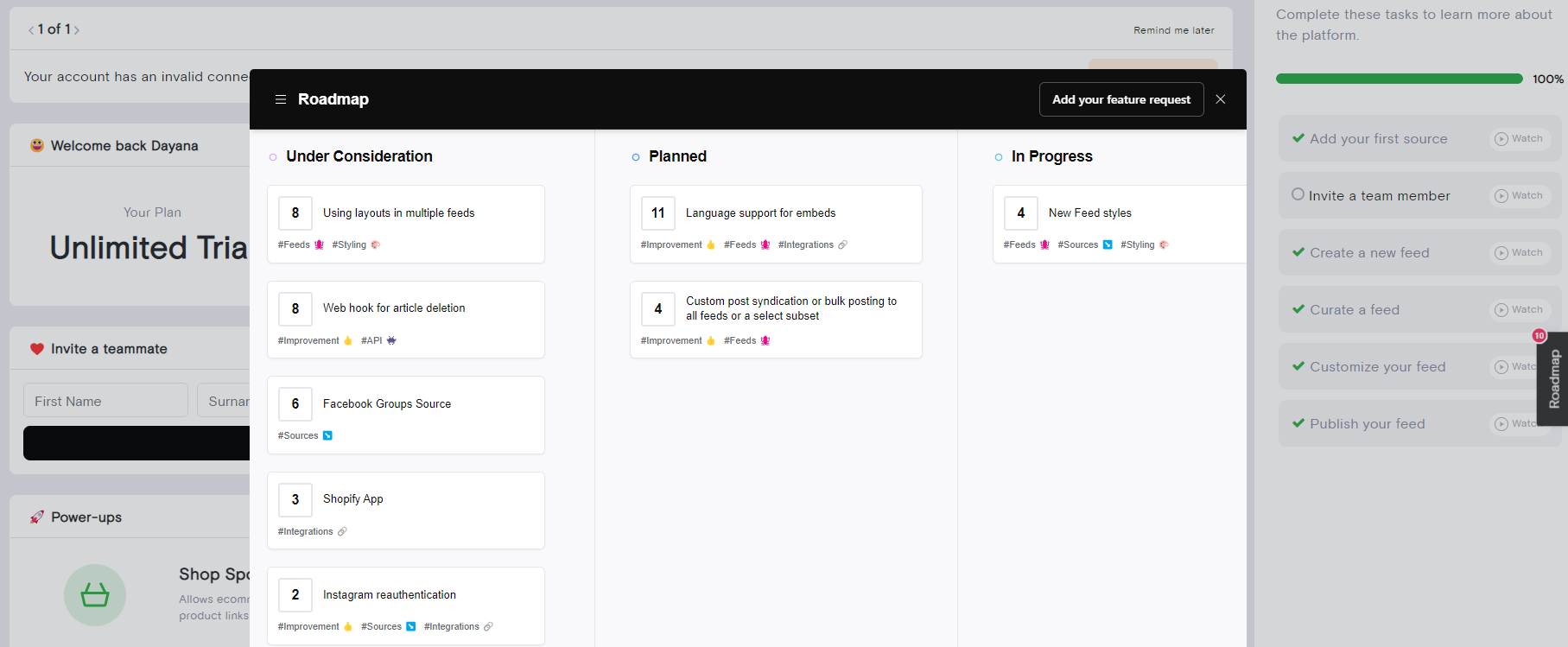
5. Dyson's website feedback form
Dyson has a feedback form on their website that's intended to collect feedback for the website, as opposed to specific products.
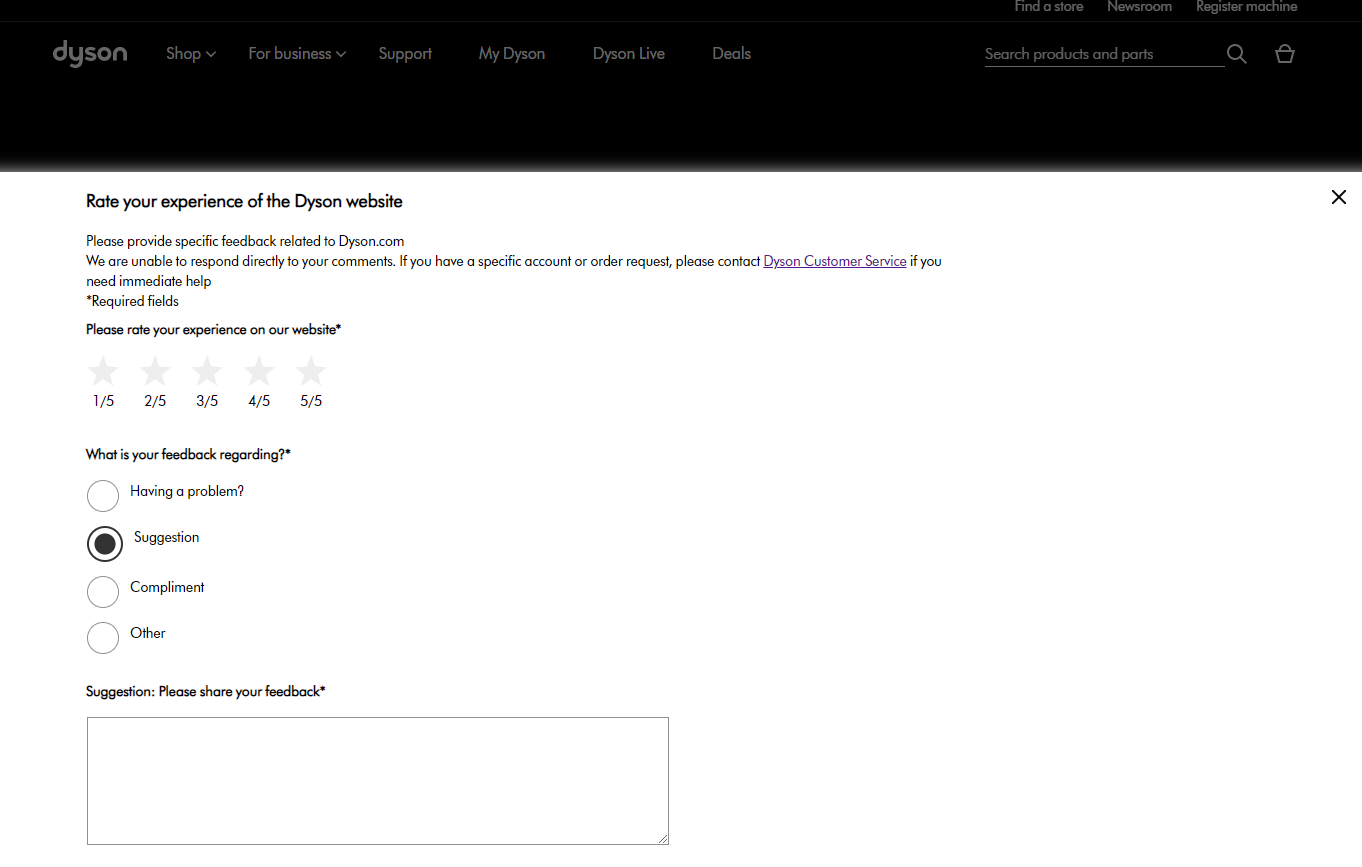
That's because a large brand like Dyson uses focus groups and social listening to collect product feedback. However, this example is still useful because it's worth remembering that your website is a product all on its own. Make sure you have a way to monitor quality metrics and site feedback.
6. Ramsey's feedback form on a specific product
Ramsey (created by financial guru Dave Ramsey), offers books, software, and other products. They recent sent out a product feedback form for a leather wallet with various envelopes for sorting cash, in order to use their signature cash envelope budgeting system.
Their product form first asked whether or not the person has purchased the wallet. If the answer was no, the next question was to understand why not.
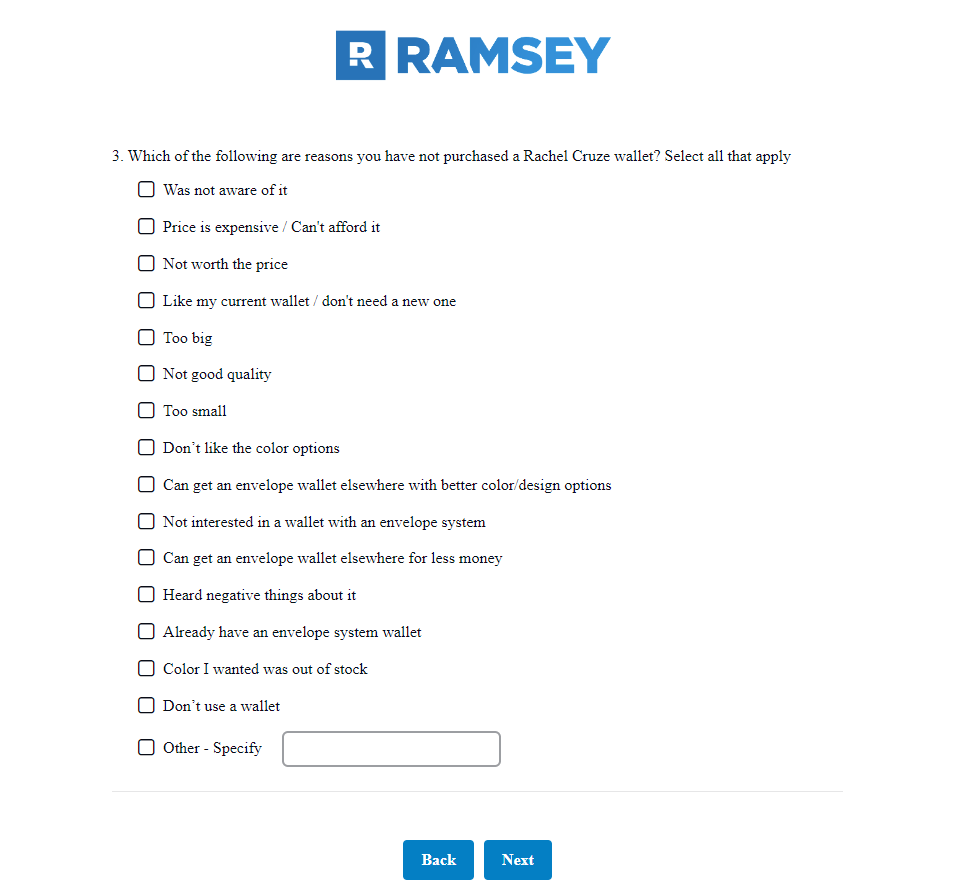
This is a great example of conditional questioning. Depending on someone's answer, you can then follow-up for more details.
Ultimately, you'll want to pick a product feedback method that matches your business.
If you're building a software or other digital product, you'll want to make the feedback process more interactive. Allow users to add ideas, upvote other ideas, and comment on each other's ideas.